Ah, full Moon. Time to put the telescope away and lead a normal life. Then again, maybe not. Here are 11 things to coax you back out for another look.
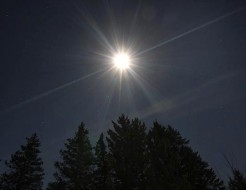
Bob King
The Moon waxes to full on July 8–9 and will be a bright presence now through next week. Full Moon time is when skywatchers get their R&R. After all that lost sleep from deep-sky hunting, planet watching, and comet chasing, we crave a break. Now, with a big, bright Moon blowing out the sky, why bother setting up the scope? Better to cradle the pillow for once.
I've been there and totally understand. But recently I discovered how much we could be missing. During June's Strawberry Moon I was scheduled to show a group of naturalists the night sky with the telescope. We filed outside into a night that seemed bright as day and spent a wonderful time observing lots of great stuff. I didn't get home till midnight.
That's what inspired me to compile this list. While the flood of moonlight precludes seeing the central star in the Ring Nebula or unveiling the Veil Nebula, we can find much enjoyment in that which we can see. Which, as it turns out, is a lot!
#1 Mercury at dusk
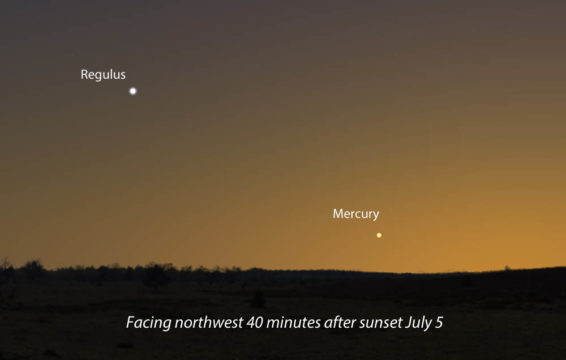
Stellarium
Let's start with Mercury. This may be a bit of a challenge at least early in the week. The good news is that Mercury is bright at magnitude +0.2 and slowly climbs away from the Sun in the coming nights.Take binoculars and look to the northwest horizon about 40 minutes after sunset.
#2 Full Moon in Earth's Shadow
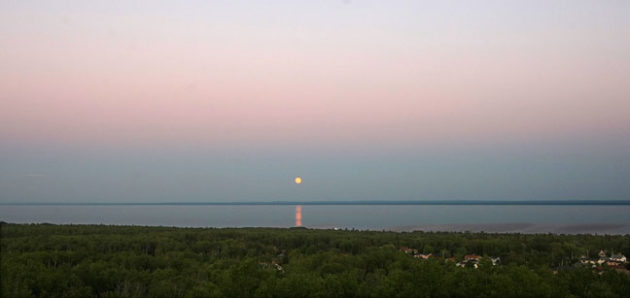
Bob King
On July 8th and 9th, the full Buck Moon will rise shortly before and after sunset, respectively. Seeing it rise with Earth's shadow at the same time makes for a spectacular sight. Find a location with a wide open view to the east. At sunset and for the next 20–25 minutes look for the dusky band of Earth's shadow accompanied by the Moon, also opposite the Sun. Above the shadow you may see a wide, luminous band of pink. That's the Belt of Venus, caused by the backscattering of sunlight by dust and other atmospheric particles at sunset.
#3 Jupiter's Great Red Spot
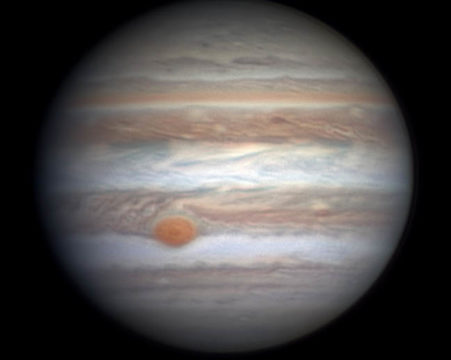
Christopher Go
Jupiter's heading west in a hurry these nights and will soon be too low in the evening sky for a good view. On July 10, NASA's Juno spacecraft will make a close flyover of the planet's most famous beauty mark, the Great Red Spot (GRS). Join the fun by having a look yourself. The list below gives the times in the coming week when it's squarely in view for observers in the Americas. The spot currently has a distinctly red hue and is located in the planet's southern hemisphere, just south of the prominent South Equatorial Belt. For more GRS transit times, login to Sky & Telescope and click here.
- Weds. July 5 — 8:29 p.m. CDT (1:29 UT on 7/6)
- Fri. July 7 — 10:08 p.m. CDT (3:08 UT 7/8)
- Sun. July 9 — 11:47 p.m. CDT (4:47 UT 7/10)
- Mon. July 10 — 7:39 p.m. CDT (0:39 UT 7/11)
- Weds. July 12 — 9:18 p.m. CDT (2:18 UT 7/13)
#4 Light-blasted Craters
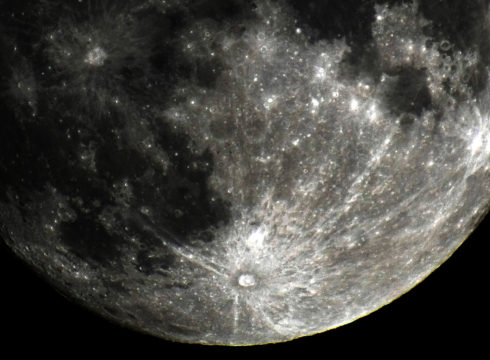
Bob King
Some amateurs don't care to look at the full Moon in a telescope without a filter because it's too bright. But I never mind as my eye soon gets used to the glare. One of my favorite sights around the time of full are rayed craters with their crowns of bright, radial streaks. The streaks were created when debris blown out by the impact rained down on the land below and excavated thousands of additional smaller craters in a rayed pattern.
Dozens and dozens pock the bright Moon, looking like brilliant stars or even (appropriately) explosions in the high Sun. Use a medium magnification of 100×–150× to get a memorable eyeful!
#5 Doubly Good Zeta CrB and Σ1964
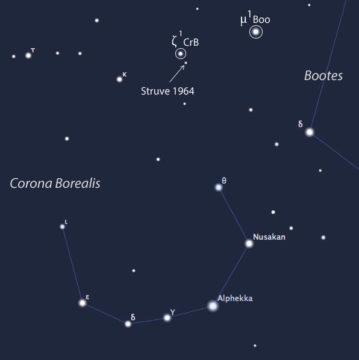
Stellarium
No double star is ever comprised by moonlight. Zeta1 (ζ1) Coronae Borealis and nearby Σ1964 form a beautiful, unrelated "double double" in western Corona Borealis, just above the top of neighboring Boötes. I like the view around 60-75×, where they make two close pairs that neatly fit in the same field of view. Their magnitudes and separations are: Zeta (mags. 5.0 and 5.9, 6.3″) and Σ1964 (mags. 7.9 and 8.1, 15.3″). If you want to sneak a peek, here's how they look in the telescope.
#6 Triple Treat Mu Boo
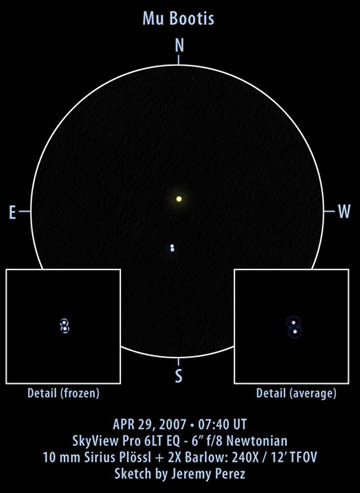
Jeremy Perez
We can't leave the neighborhood before crossing over into nearby Boötes for a gander at the striking triple star, Mu (μ) Boötis. It's only a hop away. A casual look shows a bright, yellow primary with a 7.2-magnitude companion 108″ nearly due south. Not what you'd call impressive, but don't make the mistake of moving on. When you increase the magnification to 100×, there's an Easter Egg here — the secondary splits into a fantastic, ant-like pair (magnitudes 7.2 and 7.8) separated by just 2.25″, making this a triple star system.
#7 Red-faced T Lyrae
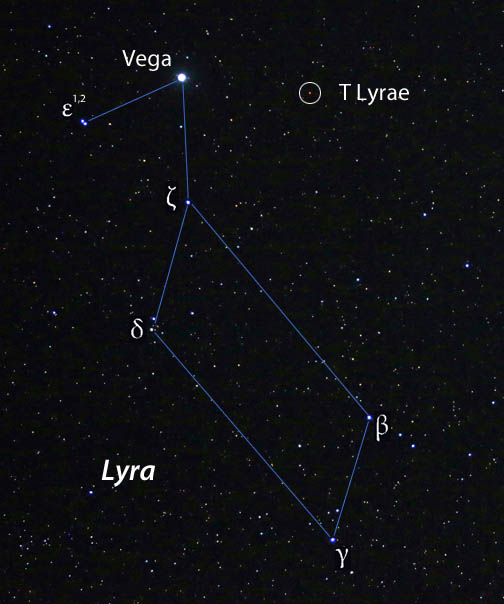
Bob King
Who doesn't love looking at red stars? Some of the most intensely red are known as carbon stars, and T Lyrae is one of the reddest. For most of a sunlike star's life, it fuses hydrogen into helium, but as it ages, the core compresses and heats up until it can cook helium nuclei into carbon. Now a red giant, convective currents dredge carbon from the core and deliver it to the star's outer layers where it forms a fine soot that scatters away blue and green light. Only oranges and reds penetrate the dusty barrier and reach our eyes. Simply put, they're gorgeous.
I looked at T Lyrae earlier this week and found it shining around magnitude 9.0 and looking Christmas-glass-ornament red. Red stars get weirder the longer you stare at them. At first glance, T appeared dark and smolder-y, but the longer I looked, the more intense and fiery the red became. You gotta see it.
#8 Sweet Beta Scorpii
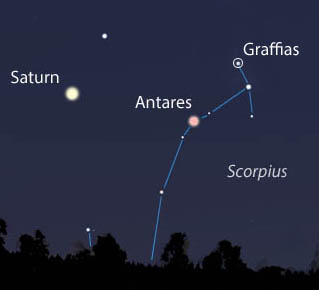
Stellarium
I can't resist adding another double star to our list. It's bright and cleaves into two shimmering stars in any telescope at 30×. On the meridian at nightfall, this gemmy pair practically calls your name. Beta (β) Scorpii's bright at magnitude 2.6, so you can see it even in full moonlight. The companion star is magnitude 4.5 and 14″ to the northeast. Also known by its proper name, Graffias, I make several pilgrimages here a year.
Both components are hot, white suns nearly 10 times as massive as our own and some 400 light-years from Earth. The pair also has a few secrets it keeps well hidden from amateur telescopes. The brighter of the two stars (the one visible with the naked eye) has two very close companions, while the fainter companion is also a tight triple star, making a total of six stars in all.
#9 Asteroid Ride
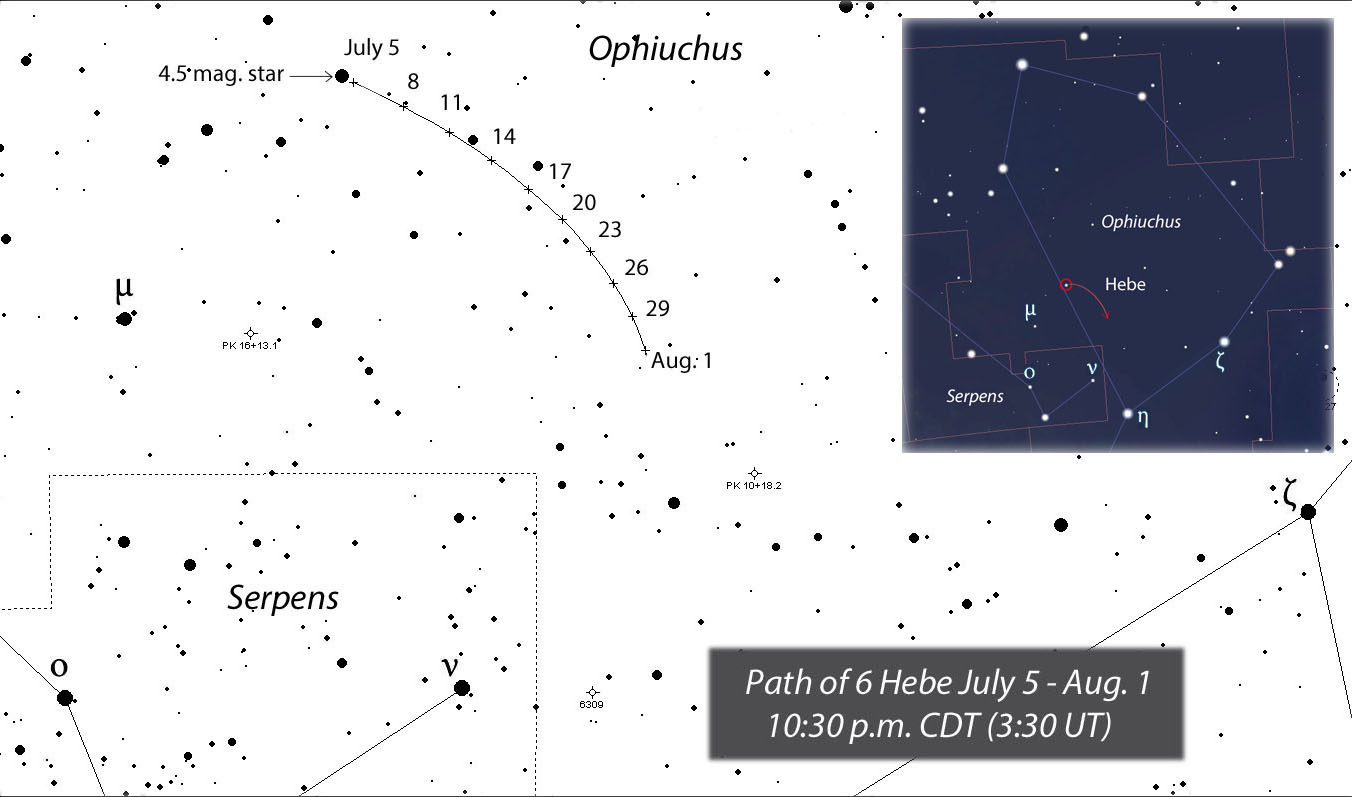
Chris Marriott's SkyMap
If you've ever handled an H-chondrite, a relatively common type of stony meteorite, you may have touched a piece of this asteroid, thought to be the parent body of the group. 6 Hebe is one of the brightest asteroids, in fifth place after Vesta, Ceres, Iris, and Pallas. This summer finds it moving south through central Ophiuchus, easily visible even in smaller telescopes at its current magnitude of 9.3.
#10 Saturn
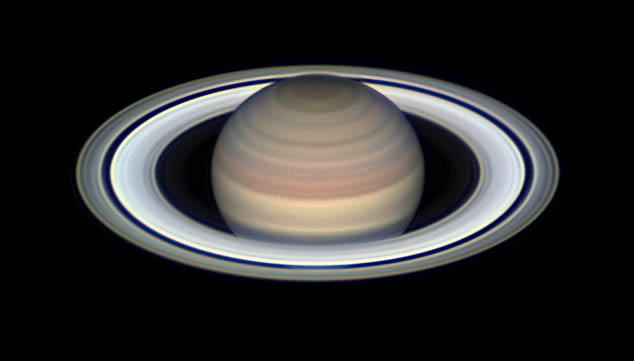
Christopher Go
Now that Saturn's six weeks past opposition, we no longer have to wait for the planet to rise high enough for a decent view in our telescopes. From latitude 40° north, it's already more than 22° at nightfall. For more information about the planet and the many things to see there, check out my earlier blog on the topic.
During the current apparition, Saturn never gets very high, so amateurs may find their views disturbed by turbulent air more often than not. That's why I encourage you to go out for a look on as many clear nights as possible to catch the few times the planet will look crystal clear and breathtaking.
#11 Venus and the Pleiades
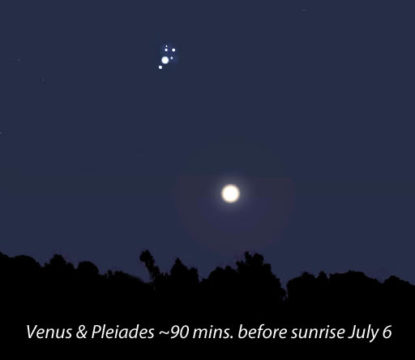
Stellarium
How sweet life is when we're up at dawn to see the Pleiades return. Hard to believe such a chilly reminder of winter appears so close to the summer solstice.They look delicate now, tempered by altitude and dawn light, but it won't be long before the swarm parades across the evening sky above tiny clouds of our own breath.
Venus follows the Pleiades by only 6°, making this a great opportunity for a photo of the pair before the sky grows too bright.
Well, now I've done it: Gone and given you another excuse to stay outside when all you really needed was rest. Happy gazing!
 4
4








Comments
Mickwilson20
July 7, 2017 at 6:57 pm
An excellent piece! Real-time guidance to a variety of object types under the less-than-optimal conditions that city-bound observers face every night, full moon or no. Please consider bringing us more guides like this!
You must be logged in to post a comment.
Bob KingPost Author
July 8, 2017 at 12:30 am
Thank you, Mick! I'd be happy to do another. I'll keep that in mind as we look ahead.
You must be logged in to post a comment.
Anthony Barreiro
July 7, 2017 at 10:24 pm
#12 (actually #3, after twilight) -- Moonlight! Sunlight, reflecting off the asphalt-dark surface of the Moon, lights up our familiar surroundings with an otherworldly cool silvery glow. Turn around and look at your Moon shadow. In these times of constant light pollution, just as many of us rarely see a truly dark sky, few of us experience the monthly waxing and waning of moonlight that was part of the fabric of our ancestors' lives.
You must be logged in to post a comment.
Bob KingPost Author
July 8, 2017 at 12:31 am
Well put, Anthony. Let there be #12!
You must be logged in to post a comment.
You must be logged in to post a comment.